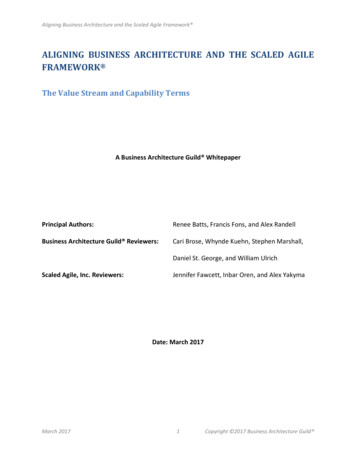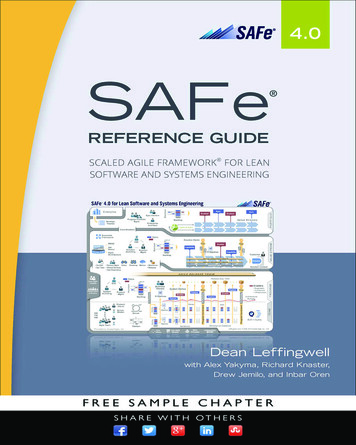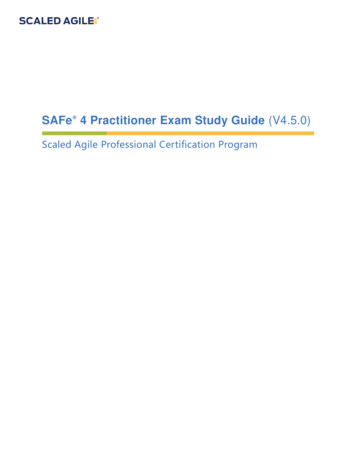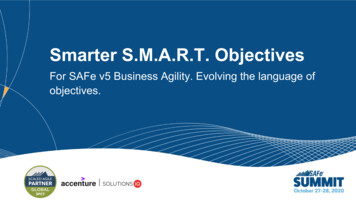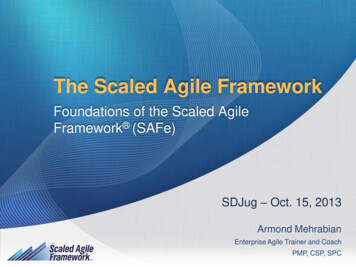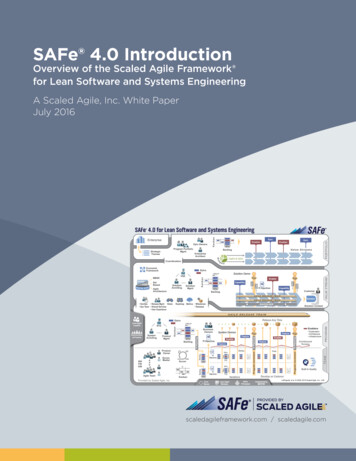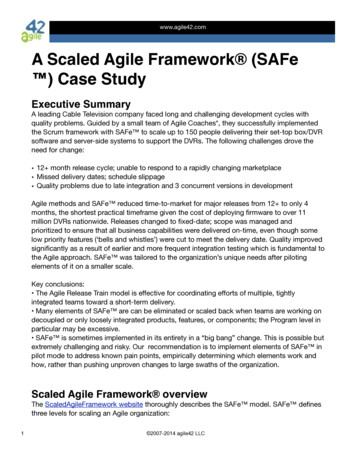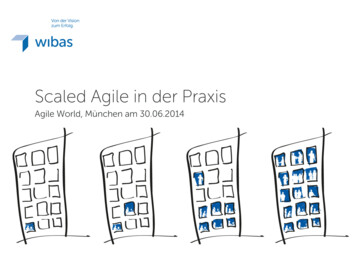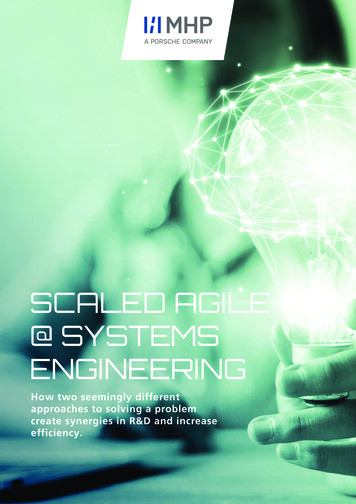
Transcription
Survey and Analysis of Scaling Agile Practicesfor an Agile IT OrganizationBinnur Karabacak, Bachelor Thesis Final Presentation, 31.07.2017, MunichChair of Software Engineering for Business Information Systems (sebis)Faculty of InformaticsTechnische Universität Münchenwwwmatthes.in.tum.de
AgendaIntroduction Motivation Research questions Research approachLarge scale agile Related work Comparison table Scaled agile framework vs. Large scale scrumLimitation and outlookBinnur Karabacak - BT Final Presentation sebis2
AgendaIntroduction Motivation Research questions Research approachLarge scale agile Related work Comparison table Scaled agile framework vs. Large scale scrumLimitation and outlookBinnur Karabacak - BT Final Presentation sebis3
Motivation Compared to traditional software, organizations have to deliver software muchfaster and better tolerate changing requirementsagile software development as an alternative to traditional methods 94% are practicing agile software development 98% realized success from agile projects Benefits of agile software development: ability to manage changing priorities better project visibility improved team productivityOrganizations face their next challenge in scaling agilepractices across the IT organizationSeveral scaling agile practices emerged to meet this challengeBinnur Karabacak - BT Final PresentationSource: based on VersionOne 2017 sebis4
AgendaIntroduction Motivation Research questions Research approachLarge scale agile Related work Comparison table Scaled agile framework vs. Large scale scrumLimitation and outlookBinnur Karabacak - BT Final Presentation sebis5
Overview of relevant research questionsResearch question 1 (RQ1):Which scaling agile practices exist?Research question 2 (RQ2):How can scaling agile practices be compared?Research question 3 (RQ3):What are the commonalities and differences between theScaled Agile Framework and Large Scale Scrum?Binnur Karabacak - BT Final Presentation sebis19
AgendaIntroduction Motivation Research questions Research approachLarge scale agile Related work Comparison table Scaled agile framework vs. Large scale scrumLimitation and outlookBinnur Karabacak - BT Final Presentation sebis7
Research Approach2. TOPIC CONZEPTUALIZATIONConcept map with relevantsearch terms3. LITERATURE SEARCHList of relevant sourcesAgileOrganizationRQ1RQ2RQ31. SCOPE OF RESEARCHResearch questions on scalingagile n4. LITERATURE ANALYSISAnalysis of comparisons ofscaling agile practices5. RESEARCH OUTCOMEDifferences and commonalitiesof SAFe and LeSSBinnur Karabacak - BT Final PresentationSource: based on Brocke 2009 sebis8
AgendaIntroduction Motivation Research questions Research approachLarge scale agile Related work Comparison table Scaled agile framework vs. Large scale scrumLimitation and outlookBinnur Karabacak - BT Final Presentation sebis9
Related Work Alqudah et al. (2106): Comparison of scaling agile practices SAFe, LeSS, DA 2.0, RAGE, Nexus, and Spotify were considered to bescaling agile methods at large organizations roles and practices of each is described practices are compared based on some criteria results are summarized, and the advantages of each practice are shown Uludağ et al. (2017): Roles of architects in scaling agile practices Identified 20 scaling agile practices and described the three most popularscaling agile practices, namely the Scaled Agile Framework (SAFe), LargeScale Scrum (LeSS), and Disciplined Agile 2.0 (DA 2.0) the roles of enterprise, software, solution, business, information, andintegration architects, as identified in six different scaling agile practices, arecharacterizedBinnur Karabacak - BT Final Presentation sebis10
AgendaIntroduction Motivation Research questions Research approachLarge scale agile Related work Comparison table Scaled agile framework vs. Large scale scrumLimitation and outlookBinnur Karabacak - BT Final Presentation sebis11
Comparison criteria of different sourcesDolman et al. (2014) comparesSoS, LeSS, SAFe, DAD, Spotify,DSDM, RAGE, Nexus and Scrumat Scale based on: DescriptionWeb LinkPopularity/AdoptionPortfolioProgram structureInter-team coordinationTeam levelTech practicesCompleteness of coverageAvailability of Details & SupportWhat Team level frameworks aresupportedEmphasizes more Central control ordistributed, Scale / Target size,Used typically by what OrganizationTypesFocal pointSoftware centrichow often used outside of SW or ITBig Positives / Key DifferentiatiatorsKey Risks / ConcernsTrainingBinnur Karabacak - BT Final PresentationKapadia (2014) comparesSAFe, LeSS and DAD basedon: StyleBuilding blockDistinctive eventsBooksWebsitesDistinctive rolesCertificationsFoundationAlqudah (2016) comparesSAFe, LeSS ,DAD, Spotify,Nexus and RAGE based on: Team sizeTrainings and certificatesTechnical Practices requiredRolesOrganization typeMethods and practices adoptedPant (2016) comparesSAFe, LeSS and DAD basedon: DescriptionPortfolioProgram structureInter-team coordinationTeam levelTech practicesWest (2016) comparesAgilePath, Continuous Agile,DSDM, SAFe, LeSS ,DAD,Spotify, Nexus, Fast Agile,ScALeD, Scrum at Scale,XSCALE and RAGE basedon: Enterprise-TargetedWeb-Scale-TargetedSource of PracticesPublished Case Studies sebis12
Comparison TemplateCharacteristicAbbreviationShort descriptionScaled Agile FrameworkLarge Scale ScrumMethodologistDescriptive Information OrganizationPublication dateCategoryWebsiteNumber ofacademiccontributionNumber of statedcasesDocumentationAdoptionAvailability oftraining courses andcertificationsAvailability of acommunity/blog/forumScope levelFoundationalpracticesand methodsApproach forSoftwareDevelopmentScopeIteration time periodTeam sizeRolesEventsArtifactsConceptsBinnur Karabacak - BT Final Presentation sebis13
AgendaIntroduction Motivation Research questions Research approachLarge scale agile Related work Comparison table Scaled agile framework vs. Large scale scrumLimitation and outlookBinnur Karabacak - BT Final Presentation sebis14
Scaled Agile Framework (SAFe)Binnur Karabacak - BT Final PresentationSource: based on SAFe 2016 sebis15
Large Scale Scrum (LeSS)Source: based on LeSSBinnur Karabacak - BT Final Presentation sebis16
Comparison of SAFe and onScaled Agile FrameworkSAFeLarge Scale ScrumLeSSShort descriptionSAFe is a knowledge base ofproven patterns for implementing LeSS is one-team Scrum appliedto many teams who are workinglean and agile softwaretogether on one productdevelopment and systemdevelopment at enterprise scaleMethodologistDean LeffingwellCraig Larman,Bass VoddeOrganizationScaled Agile Inc.LeSS Company B.V.Publication caledagileframework.com www.less.worksAdoptionScopeSource: based on SAFe 2016, LeSSBinnur Karabacak - BT Final Presentation sebis17
Comparison of SAFe and LeSSCharacteristicScaled Agile FrameworkLarge Scale ScrumCharacteristicAbbreviationShort descriptionCreatorDescriptive Information OrganizationPublication dateCategoryCategory WebsitePresence inacademiccontributionsNumber ofacademiccontributionPresence instated casesAdoptionNumber of statedcasesDocumentationTraining coursesandCertificationsCommunity/Blog/ForumScope levelFoundationalpracticesand methodsRolesEventsTeam sizeScopeApproach forSoftwareDevelopmentScaled Agile FrameworkLarge Scale ScrumIteration time periodArtifactsConceptsDescriptive InformationNumber ofacademiccontribution3529Number of statedcases3823DocumentationHomepage, Books, WhitepaperHomepage, BooksAdoptionAvailability oftraining courses and yescertificationsyesAvailability of acommunity/blog/forumyesyesScopeSource: based on Uludağ, SAFe 2016, LeSSBinnur Karabacak - BT Final Presentation sebis18
Comparison of SAFe and LeSSCharacteristicScaled Agile FrameworkCharacteristicAbbreviationShort descriptionCreatorDescriptive Information OrganizationPublication dateCategoryCategory WebsitePresence inacademiccontributionsNumber ofacademiccontributionPresence instated casesAdoptionNumber of statedcasesDocumentationTraining coursesandCertificationsCommunity/Blog/ForumScope levelFoundationalpracticesand methodsRolesEventsTeam sizeScopeApproach forSoftwareDevelopmentLarge Scale ScrumDescriptiveInformationScaled Agile FrameworkLarge Scale ScrumIteration time periodArtifactsConceptsAdoptionScopeScope levelAll levelsAll levelsFoundational practicesand methodspractices: lean productdevelopment and flow, systemthinking, agile developmentmethods: Scrum, XP, Kanbanpractices: lean thinking, systemthinking, agile developmentmethods: ScrumApproach for SoftwareDevelopmentiterativeiterativeIteration time periodrecommended as 2 weeks, butcan last from one to four weeks2-4 weeksteam sizeSmall LeSS: 2-8 team, with up toRelease Train: 5-12 agile teams8 team membersAgile Team: 5-9 agile teamLeSS Huge: more than 8 teamsmemberswith up to a few thousand peopleSource: based on SAFe 2016, LeSSBinnur Karabacak - BT Final Presentation sebis19
Comparison of SAFe and LeSSCharacteristicAbbreviationShort descriptionCreatorDescriptive Information OrganizationPublication dateCategoryCategory WebsitePresence inacademiccontributionsNumber ofacademiccontributionPresence instated casesAdoptionNumber of statedcasesDocumentationTraining coursesandCertificationsCommunity/Blog/ForumScope levelFoundationalpracticesand methodsRolesEventsTeam sizeScopeApproach forSoftwareDevelopmentRolesTeam level: Product Owner,Scrum Master, Agile TeammembersProgram level: ProductManager, Release TrainEngineer, System architect,Business Owner, StakeholderValue Stream level: ValueStream Engineer, Solutionmanager, Solution architectPortfolio level: Epic Owner,Enterprise ArchitectSmall LeSS: Product Owner,Scrum Master, DevelopmentteamLeSS Huge: Product Owner,Scrum Master, Developmentteam, Area Product OwnerEventsIteration Planning, ProgramIncrement (PI) Planning, dailyStand-Up, IterationRetrospective, System Demo,Inspect and Adapt, IterationReview, Pre- and Post-PIPlanning, Solution DemoSprint, Sprint Planning (One andTwo), Daily Scrum, SprintReview, Sprint Retrospective,overall retrospective meetingArtifactsSmall LeSS: product increment,Team Backlog, Portfolio Backlog,Product Backlog, Sprint Backlog,Program and Value StreamLeSS Huge: Area ProductBacklogBacklogConceptsProgram Increment, AgileRelease Train, Value Streams,Architecture Runway, SpanningPaletteScopeScaled Agile FrameworkLarge Scale ScrumIteration time periodArtifactsConceptsRequirement AreaSource: based on SAFe 2016, LeSSBinnur Karabacak - BT Final Presentation sebis20
Main findings Both frameworks try to address practices beyond the team level SAFe offers a more governance oriented and prescriptive framework with clearroles and responsibilities than LeSS Small LeSS and the 3-level-view of SAFe are both designed for small agileteams, whereas LeSS Huge and the 4-level-view in SAFe support building largesolutions that typically require hundreds or more people to build and maintain SAFe assumes an intentional and emergent architecture and covers the roles ofarchitects;LeSS assumes an emergent architecture, but does not cover the roles ofarchitectsBinnur Karabacak - BT Final Presentation sebis21
Main findings SAFe and LeSS have partially the same artifacts, events, and roles, but mayhave different namesartifactseventsrolesSAFeLeSSworking software incrementproduct incrementteam backlogprogram backlogvalue stream backlogportfolio backlogproduct backlogiterationsprintiteration planningsprint planningteam demosprint reviewagile team memberfeature teamagile teamscrum teamSource: based on Kaczmarek 2016Binnur Karabacak - BT Final Presentation sebis22
Limitations and Outlook Only two scaling agile practices were compared Comparison of other scaling agile practices in future Recently, SAFe 4.5 was released, but SAFe 4.0 is described and compared withLeSS Interviews with organizations about how they use scaling agile practicesBinnur Karabacak - BT Final Presentation sebis23
DiscussionThank you for your attention!Do you have any questions?Binnur Karabacak - BT Final Presentation sebis24
Sources[1] VersionOne Inc. (2017). the 11th annual State of Agile Report. accessed: 2017-07-27.[2] J. Vom Brocke, A. Simons, B. Niehaves, K. Riemer, R. Plattfaut, and A. Cleven. (2009),“Reconstructing the giant: On the importance of rigour in documenting the literature searchprocess,” in ECIS, vol. 9, pp.2206–2217.[3] Alqudah, M.; Razali, R. (2016). A Review of Scaling Agile Methods in Large SoftwareDevelopment. International Journal on Advanced Science Engineering Information Technology, 6(6), 828-837.[4] Dolman, R.; Spearman, S. (2014). Links. Retrieved from Agile Scaling:http://www.agilescaling.org/links.html. accessed: 2017-07-27.[5] A. Pant, “Agile methodology: Implementing the best scaled agile framework for faster and betterbusiness results,” Tavant Technologies, Tech. Rep., 2016.[6] S. V. D. Z. Mike West, Nathan Wilson, “Market guide for enterprise agile frameworks,” Gartner,Tech. Rep., 06 2016.[7] Kapadia, M.: Introduction to Enterprise Agile Frameworks, Salt Lake City, Utah 2014.[8] Uludağ, Ö.; Kleehaus, M.; Xu, X.; Matthes, F.: Investigating the Role of Architects in Scaled AgileFrameworks, 21th Conference on Enterprise Distributed Object Computing (EDOC), Québec City,Canada 2017.[9] “Safe 4.0 for lean software and systems engineering”, http://scaledagileframework.com/,accessed: 2017-07-27.[10] LeSS Framework, https://less.works/ , accessed: 2017-07-27.[11] Kaczmarek, C. (2016). Organisation in einer Digitalen Zeit: Ein Buch für die Gestaltung vonreaktionsfähigen und schlanken Organisationen mit Hilfe von skalierten Agile & Lean Mustern.Darmstadt: Wibas GmbHBinnur Karabacak - BT Fi
Characteristic Scaled Agile Framework Large Scale Scrum Descriptive Information Abbreviation SAFe LeSS Short description SAFe is a knowledge base of proven patterns for implementing lean and agile software development and system development at enterprise scale LeSS is one-team Scrum applied to many teams who are working together on one product Methodologist Dean Leffingwell
